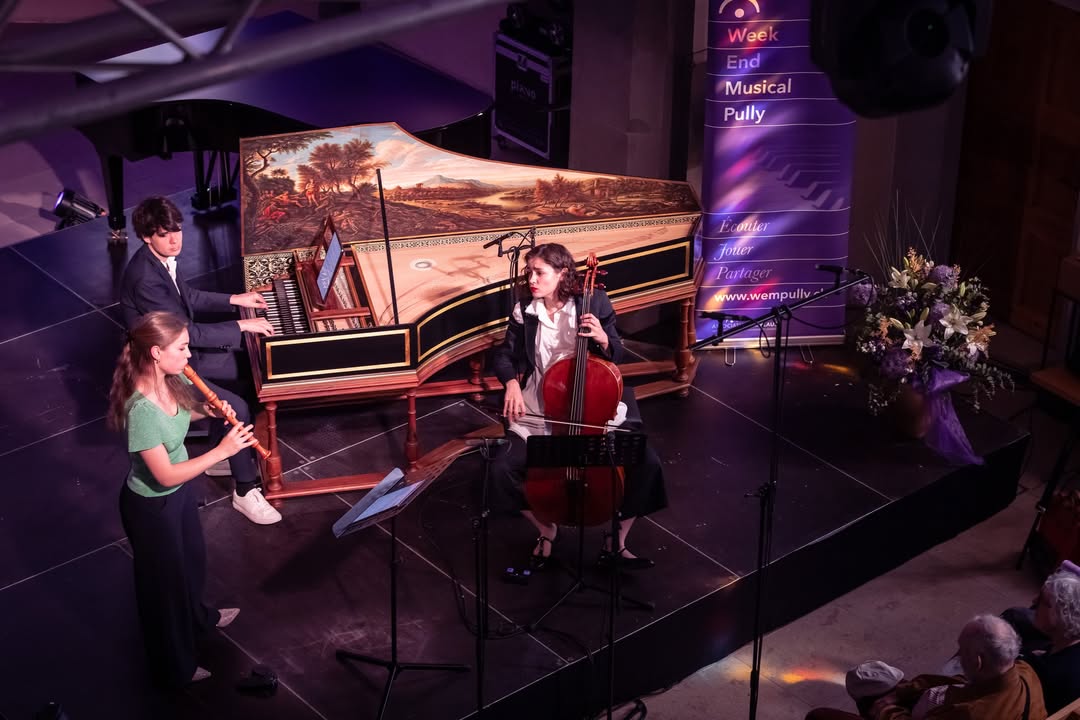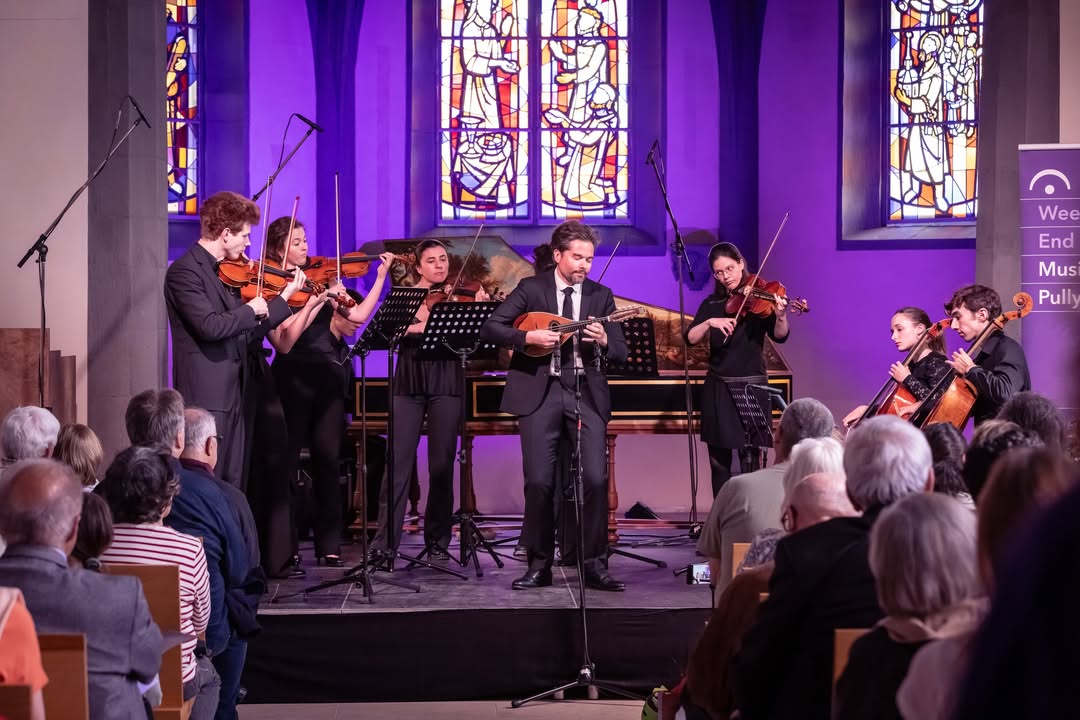Week-end musical de Pully
I went to the Week-end musical de Pully in Switzerland with a friend, where several concerts were held.
- Lucie Horsch on the recorder: I really enjoy the passion and technique she brings to the music.
- Anastasia Kobekina on the cello: I think it was the first time I listened to the cello played as a solo instrument… it was beautiful.
- Justin Taylor on the harpsichord.

Lucie Horsch, Anastasia Kobekina and Justin Taylor at Pully (wempully.ch)
A special mention goes to Julien Martineau on the mandolin, who also gave a spectacular performance on an instrument I was not very familiar with. We missed the first part, but my friend, who also plays the mandolin, really enjoyed his performance and even had the chance to chat with him.

Julien Martineau (center) at Pully (wempully.ch)
Recorder workshop
I also had the opportunity to attend a recorder workshop given by Lucie Horsch for 8 students. Lucie asked a few questions and provided guidance, helping the students with their technique.
Preconceptions
The workshop began with a simple question: “What preconceptions did you have?” The students all responded similarly:
- the recorder is an “entry-level” instrument before progressing to something else
- why don’t you study the flute?
- in French, the word for recorder is “flûte à bec,” and it needs to be specified, otherwise, people assume you mean the flute (“flûte traversière”)
- is studying the recorder a joke?
I guess the answers were a bit stereotypical, but it was somewhat expected.
Techniques
Here are some general tips on technique.
Registers
- low register: use more air, otherwise, the sound will be too weak compared to the other notes.
- high register:
- more air is not helpful; you need faster air for a more beautiful and accurate note
- closing your teeth can help speed up the air (I did not succeed in doing this…)
- it is possible to achieve a softer high E by closing the bell more; it will become an F
Posture
- stay as still and stable as possible
- try playing against a wall with your head touching it to maintain a straight posture and reduce movement
- keep your elbows stable; do not let them move around when practicing
- walk while playing to improve your control over rhythm
- be more self-aware of your body and your overall posture, not just on autopilot. Try to stay in control of your movements
Fingers
- do not tense the fingers too much. Check by quickly lifting and closing them: you should hear a light “pop” when they touch the recorder
- moving the fingers away from the holes when reducing the breath can help maintain the note at the same level. It is difficult, but worth it! (It’s like a “superpower”)
Thumb position
- close the thumb more for higher notes
- the higher the note, the more precise the thumb position needs to be
- the more it is closed, the sweeter the high note will sound
- use the thumbnail for precision: it is harder and more accurate than the flesh. The angle matters too. Practice is important, but in real life,you will not always have time to get the perfect angle
On the Alto recorder, the left hand may be more notched, and the thumb may be flat along the recorder. However, it is important not to create tension in the left hand.
Personal note: the book The Modern Recorder Player suggests using the left hand in a relaxed position and slightly bending the thumb:
It is essential that you don’t close the thumbhole with the tip of the thumb, but again with the side of the top joint – half flesh, half nail
Every recorder is different
Some advice when checking or playing a new recorder:
- do not just try the high notes, try all the notes to get a feel for all registers
- pay attention to the distance between the labium and the finger holes
- notice how far the air travels in the recorder; you need to feel it
- play a Telemann fantasy to test the instrument – he was a virtuoso on the recorder
A student had a lot of trouble reaching the high F on her recorder. Lucie tried to use the recorder herself to reach high F but was also unable to. Sometimes the student is at fault; sometimes it is just the tool. Make sure the recorder you use is actually working properly; otherwise, even if you play perfectly, a wrong note will be produced.
Exercises
- use alternative fingerings to add more dynamics
- practice dotted eighth-sixteenth and double-dotted sixteenth rhythms to improve control and awareness of the notes you are playing
- take your time with ornamentations, but do not make them too long
Warm-up
- use the D note to test the air and limits of the recorder, experimenting with both insufficient and excessive breath to find the right balance
- if you have the right air, you will feel the vibrations. Do not squeeze your fingers too much; relax, or you will not feel the resonance
- try a vibrato exercise to get in tune with yourself
- test the high F to figure out the angle and thumb opening
Breathing
- be conscious of your breathing, and do not interrupt the music. “Breathing is for amateurs”, her teacher used to say about the flute :)
- do not distract the audience with your breathing
- do not be afraid to cut a note short to breathe, rather than running out of air and running out of air mid-note
The next generation
From what I gathered, all students except one who participated in the workshop had the same professor. They began individually and later worked as a group.
As the workshop was about to end, the professor and her students left for other activities at the festival. However, a little girl, around 9 or 10, was left behind. Lucie kindly took extra time to work with her.
It turned out that this little girl was more advanced and skillful than all the other students. It was as if she could truly feel the instrument and the music. She played duets with Lucie for around 15 minutes. The two played beautifully, and it was the most enjoyable moment of the workshop – like a mini-concert.
A huge thank you to both of them!
Conclusion
I had a fantastic time attending the concerts and the workshop. I feel that the advice Lucie gave the students can also benefit my own practice.
There were very few of us in the audience, so we had the chance to exchange quite a few words with Lucie, who is very kind. It is clear that she has a deep love for the recorder.
I just wish I had more time to ask her more questions…
After a selfie with her: À la prochaine !